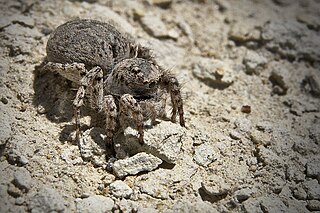
Afraflacilla is a genus of the spider family Salticidae. Most species are distributed in Eastern to Northern Africa and Australia, with one species found in Europe. This genus was for a time included in the genus Pseudicius, and the boundaries between both genera are disputed. In 2016 Jerzy Prószyński erected the genus Psenuc for some borderline species. The name Afraflacilla is combined from Africa, where most earlier described species were found, and FlacillaSimon, 1901, an obsolete salticid genus now called FlacillulaStrand, 1932. This genus name is in turn derived from Aelia Flaccilla, wife of Roman Emperor Theodosius I. Afraflacilla, Pseudicius, Festucula and Marchena are close relatives and form a monophyletic group.
Grossopterus is a genus of prehistoric eurypterid classified as part of the family Waeringopteridae. The genus contains two species, G. inexpectans from Gilboa, United States and G. overathi from Overath, Germany.
Moselopterus is a genus of prehistoric eurypterid from the Devonian period in Europe. The genus contains three species, M. ancylotelson and M. elongatus from Germany and M. lancmani from Latvia.

Waeringopterus is a genus of prehistoric eurypterids from the Silurian of North America. The genus contains two species, W. apfeli from the Syracuse and Vernon Formations of New York and Ontario and W. cumberlandicus from the Wills Creek Formation, West Virginia. Fossils of the genus also were found in the Indian Point Formation of Quebec.

Kokomopterus is a genus of prehistoric eurypterid. The genus contains a single species, Kokomopterus longicaudatus, known from the Silurian of Kokomo, Indiana.
Tarsopterella is a genus of prehistoric eurypterid classified within the family Hardieopteridae. It contains only one species, T. scotica from the Lower Devonian of Scotland.

Stylonurus is a genus of prehistoric eurypterid of the family Stylonuridae. The genus contains three species: Stylonurus powriensis from the Devonian of Scotland, Stylonurus shaffneri from the Devonian of Pennsylvania and Stylonurus perspicillum from the Devonian of Germany.

Ruedemannipterus is a genus of prehistoric eurypterid classified as part of the family Dolichopteridae. The genus contains one species, R. stylonuroides, known from the Silurian of New York.
Lamontopterus is a genus of prehistoric eurypterid classified within the family Kokomopteridae. It contains one species, Lamontopterus knoxae, from the Early Silurian of Scotland.

Pagea is a genus of prehistoric eurypterid classified as part of the family Stylonuridae. It contains three species, all from the Devonian; P. plotnicki from Nunavut, Canada and P. sturrocki and P. symondsii from the Old Red Sandstone of the United Kingdom. The genus is named in honor of David Page, an early worker on the fauna of the Old Red Sandstone and describer of the first Stylonurine eurypterid.
Woodwardopterus is a genus of prehistoric eurypterid classified as part of the family Mycteroptidae. The genus contains one species, W. scabrosus, from the Carboniferous of Glencartholm, Scotland.

Laurieipterus is a genus of a eurypterid classified as part of the family Stylonuridae. It contains one species, L. elegans from the Early Silurian of Scotland.
Lipocrea epeiroides is an orb-weaving spider species found in Greece, Cyprus, Turkey, Israel, Yemen and India.
Aituaria is a genus of spiders in the family Nesticidae. It was first described in 1998 by Esyunin & Efimik. As of 2016, it contains two species, Aituaria nataliae and Aituaria pontica, the latter of which was transferred from Nesticus first to Carpathonesticus, then to Aituaria.
Speleoticus is a spider genus in the family Nesticidae. Its species are found in Japan and China.
Aituaria nataliae is the type species of Aituaria, a genus of araneomorph spiders of the family Nesticidae. It occurs in the steppes of the southern Urals.

Aelurillus leipoldae is a species of jumping spider that lives on the island of Crete in Greece.

Stoermeropterus is a genus of prehistoric eurypterid from the Silurian period in Europe and North America classified as part of the Moselopteridae family. The genus contains three species, S. conicus and S. latus from Ringerike, Norway and S. nodosus from West Virginia.
Marsupipterus is a genus of prehistoric eurypterid with an uncertain classification. The genus contains one species, M. sculpturatus, from the Silurian of England.
Saphrys tehuelche is a species of jumping spider. The species was classified in the genus Euophrys from its first description by María Elena Galiano in 1968 until 2015. It can be found in Chile.








